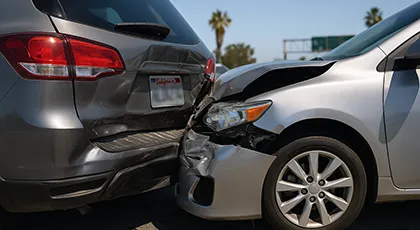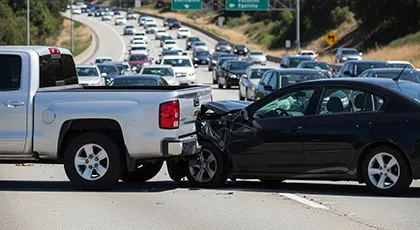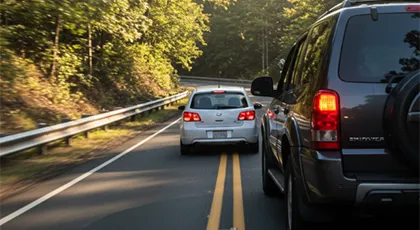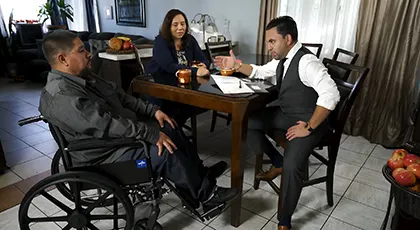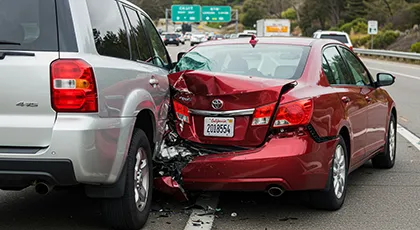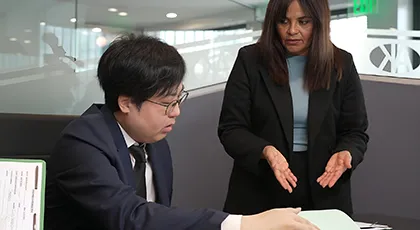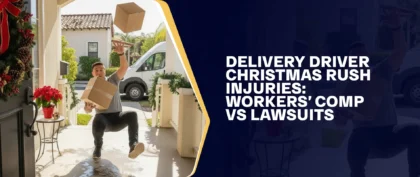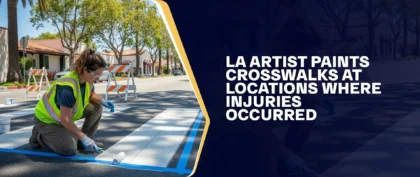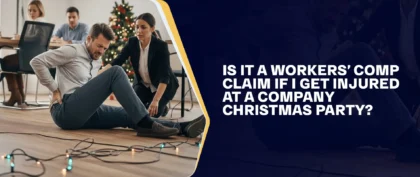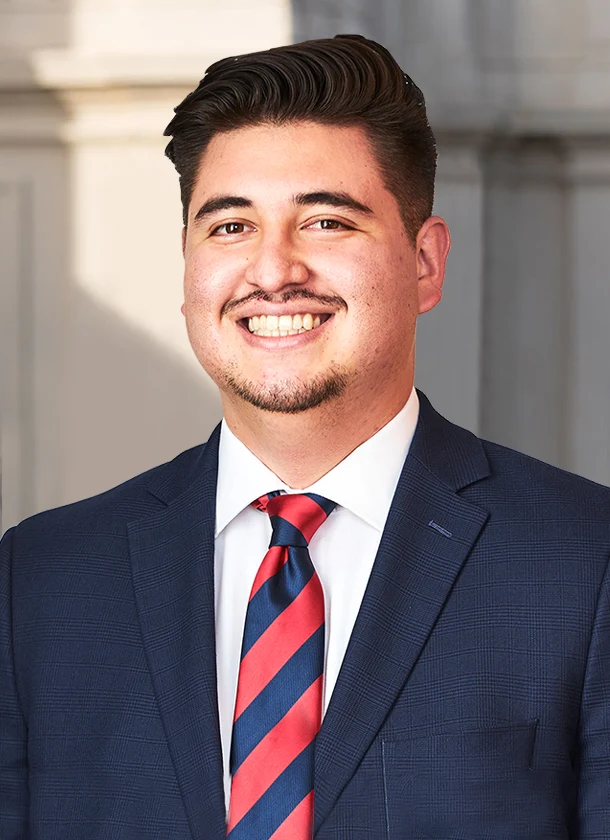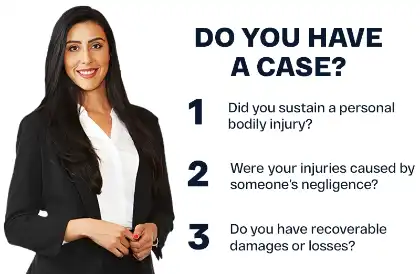Table of Contents
Rear-End Crashes: What Percentage Of Accidents Do They Cause & Why They Happen So Often
Rear-end accidents make up nearly 29% of all motor vehicle crashes in the U.S., making them one of the most common types of accidents. They also account for about 7.5% of fatal crashes. These accidents often happen when drivers are distracted, follow too closely, or fail to react in time. In some cases, the driver in front may brake suddenly or stop without warning.
Even though the impact happens in seconds, the injuries and financial effects can last much longer. Victims may suffer from whiplash, herniated discs, or other neck and back injuries. Seatbelts help, but the jolt from behind can still cause serious harm.
Understanding the causes and effects of a rear-end crash can help you protect your rights. If you were hurt in one of these collisions, the car accident lawyers at Arash Law can guide you through your legal options.
Call (888) 488-1391 or fill out our contact form to schedule a free initial consultation.
Reasons Why Rear-End Accidents Are Common
You might be asking yourself, ‘How common are rear-end collisions?’ Rear-end crashes account for approximately 29% of all car accidents in the United States and 7.5% of fatal crashes, making them one of the most common collision types, especially in urban traffic and highway congestion. Here are some of the usual contributing factors:
Driver Distraction
When drivers are not paying attention, they may react more slowly. If the car in front of them stops suddenly, they might not brake in time to avoid a crash. In California, it is against the law to drive while doing anything that takes your focus off the road.
Common examples of accident-causing distractions include:
- Eating or drinking.
- Typing in a location on a GPS.
- Texting or using mobile phones.
- Reaching for something that fell.
- Taking care of young children while driving.
- Talking to passengers, like customers in a taxi or ride service.
According to NHTSA, distracted driving caused 3,275 deaths in 2023. Distracted driving accidents are a frequent cause of rear-end crashes. Rear-end collision lawyers can use evidence such as phone records and surveillance footage to show if the at-fault driver engaged in distracted driving.
Another common cause of rear-end crashes is not leaving enough space between vehicles.
Following Too Closely
This behavior, commonly known as tailgating, frequently occurs on highways and in parking lots. Under California law, it is illegal to drive too close to the car in front of you.
According to a study, 77% of drivers had tailgated other vehicles. Several factors contribute to this dangerous behavior:
- Heavy or congested traffic that limits the ability to maintain a safe distance.
- Not knowing how to keep a safe following distance.
- Aggressive driving or road rage.
When a driver is following too closely, it makes it harder for them to stop in time. Rear-end crashes often happen in these situations, especially on highways. One way to reduce these accidents is to keep enough space between your car and the one in front while driving. You may use the following:
- Three-Second Rule — To follow the three-second rule, pick something on the side of the road, like a sign or tree. When the car ahead passes it, count “one thousand one, one thousand two, one thousand three.” If you pass the same spot before you finish counting, you’re too close and need to slow down.
- Tires on Tar Rule — When you stop at a red light, make sure you can see the back tires of the car in front where they touch the road. If you can see the tires from above your car’s hood, you’re likely at a safe distance.
Lawyers for car accidents may be able to prove that tailgating caused the rear-end collision through evidence. If a car has rear cameras, they may help. Traffic camera footage may also reveal whether the rear driver was following too closely.
Brake Or Vehicle Malfunctions
Even careful drivers may get into rear-end collisions because a vehicle’s parts might fail. A crash may happen if:
- The Brakes Fail to Work Properly — If the rear driver has brake failure, they may not be able to stop when the front car stops. Sometimes, the driver ahead also has brake problems, which makes the situation more dangerous.
- The Car in Front Has Broken or Missing Brake Lights — Without brake lights, it is hard to tell when the other vehicle is slowing down, increasing the chance of a crash.
There are many causes for these problems, including:
- Inadequate Maintenance — If the car’s owner failed to keep the vehicle in good condition, they might be responsible for the accident.
- Defective Parts — In some situations, the manufacturer or repair shop could be at fault if a faulty product or poor repair work caused the crash.
Investigations may reveal that vehicle problems caused the incident. That’s why traffic officers may give tickets to cars with broken lights to prevent these kinds of accidents. In California, most modern vehicles must have two working red tail lamps, one on each side, visible from 500 feet or more. It is also illegal to drive cars that are not in good operating condition.
Sudden Stops Or Brakes
Rear-end crashes may happen when a driver suddenly hits the brakes because of something unexpected. These sudden stops require quick thinking and fast reactions to avoid an accident and keep traffic moving safely.
Some typical situations that make a driver stop suddenly include:
- A pedestrian or animal suddenly crosses the road.
- A broken-down vehicle or debris appears in the lane.
- A driver brake-checks for no valid reason.
- A traffic light changes faster than expected.
- Unexpected road or construction work.
Driving Above The Speed Limit
Speeding makes roads more dangerous and increases the risk of rear-end crashes. Fast drivers have less time to react when traffic slows or stops. Even if they brake, it might not be enough to avoid hitting the car in front.
Here are a few key points about speeding and rear-end crashes:
- Less Reaction Time — Speeding drivers may not have enough time to stop when something unexpected happens.
- Harder Impact — Crashes at higher speeds may lead to catastrophic injuries and greater damage.
Rear-end collisions happen often, and speeding is a factor in many serious incidents, including fatal car accidents. The California Office of Traffic Safety (OTS) reports that in 2016, over one-third (35.1%) of fatal and severe injury crashes from speeding were rear-end collisions.
Poor Weather Conditions
Rear-end crashes are more likely in bad weather. Rain, ice, or snow can make roads slippery and harder to stop on. Fog or heavy rain can also reduce visibility, making it harder to see cars slowing down ahead.
Here are some example scenarios:
- A car hits a patch of ice and slides into the vehicle in front, leaving the driver unable to stop.
- Heavy fog hides brake lights, causing a driver to crash into the car ahead.
- Rain accidents occur when a car hydroplanes, causing it to lose control while trying to stop.
- Smoke from a wildfire blocks visibility, making it hard to see traffic slowing down.
Even though drivers can’t control things like poor weather or dangerous road conditions, they are still supposed to drive more carefully when these things happen. In some cases, car accident attorneys work with experts who analyze details like skid marks to determine what happened. This analysis can reveal whether the rear driver was following too closely or if the front driver also acted unsafely.
Aggressive Driving Behavior
Aggressive drivers sometimes cause rear-end crashes. They might follow too closely to intimidate the other driver. These behaviors may include the following:
- Switch lanes quickly without warning.
- Ignore stop signs or red lights.
- Cut off other cars.
These risky actions make accidents more likely. One hazardous habit is “brake checking,” when a driver suddenly hits the brakes to scare the driver behind them.
Reckless driving accidents and failure-to-yield collisions are common results of these aggressive behaviors. Knowing what causes these crashes is helpful, but it’s just as important to understand what happens if you’re involved in one.
What Happens Next After A Rear-End Crash?
After a rear-end collision, different outcomes are possible. What happens next often depends on how severe the crash is. Here are some common consequences:
Victims May Suffer Injuries
The types and severity of injuries you can get in a rear-end car crash depend on several factors. These include how fast the car was going, how you positioned your body, and whether you wore a seatbelt.
Here are some bodily injuries that can happen in a rear-end collision:
- Traumatic brain injuries (TBIs)
- Whiplash
- Face injuries
- Soft tissue injuries
- Spinal cord injuries
- Shoulder and neck injuries
- Joint damage
- Traumatic or surgical amputations
- Head injuries
- Back injuries
Some injuries from rear-end crashes don’t show up right away. Whiplash, for example, may take a day or two before causing pain. After a collision, your body might still be in shock, which can hide symptoms. That’s why it’s important to see a doctor right after the accident, even if you feel okay.
Victims May Have To File A Claim
With the injuries and possible vehicle damage, victims may have to file a car accident claim to pursue compensation for their losses. Depending on the situation and actual damages incurred, victims may qualify for:
- Economic Damages — These losses have a clear monetary value. Examples include:
- Medical bills (doctor visits, emergency room, surgery, or hospital stays).
- Payment for treatments like physical therapy, chiropractic care, and prescription medicines.
- Lost wages from missing work.
- Damage to your car or other property.
- Out-of-pocket expenses that are directly related to the accident.
- Non-Economic Damages — These are losses that do not have a precise dollar amount but still cause pain or suffering. These may include:
- Pain and suffering
- Emotional distress
- Loss of enjoyment in life
- Loss of companionship
The long-term impact of injuries may also affect the value of claims. Some injuries from rear-end accidents may not appear immediately. Here are some things that may happen over time:
- A person may develop long-term pain months after the crash.
- They may need more medical treatment in the future.
- Some injuries could make it hard to return to their old job, which might lead to a career change.
Rear-End Collision Lawyers May Help Victims Establish Liability
Rear-end crashes can be more complicated than they seem. Victims may need a lawyer’s help to establish liability. Auto accident attorneys who handle rear-end collisions often do this by showing that the other driver was negligent.
To demonstrate negligence, they usually need to show four main things:
- Duty of Care — Every driver must operate their vehicle safely. They must keep a safe distance and pay attention to traffic.
- Breach of Duty — The driver didn’t meet that responsibility. For example, they may have been texting, speeding, or not paying attention.
- Causation — The crash must result directly from the driver’s negligent action. If the driver was distracted and hit the car in front, that shows a clear connection.
- Damages — The victim must have suffered damages because of the crash. Examples include injuries, medical bills, missed work, or pain and suffering.
Lawyers for car accident victims may use the following pieces of evidence to establish the elements of negligence:
- Eyewitness Statements — Their accounts can support one party’s version of events or challenge the opposing side’s claims.
- Photos and Videos — Pictures of the accident may show where the cars ended up, how bad the damage was, and what the road looked like.
- Physical Evidence — Some examples are skid marks on the road, car dents, or paint transferred between vehicles.
- Expert Testimony — Accident reconstructionists can examine the damage, road conditions, and other details to recreate the accident. Their reports can help prove who was responsible.
- Security Camera Footage — The video may show how the crash occurred and which driver was at fault.
Who Is Responsible For A Rear-End Collision?
Rear-end collisions are usually blamed on the rear driver, but that’s not always the case. In some situations, the front driver may be at fault.
The driver in the back might be at fault if they:
- Followed too closely or tailgating.
- Drove above the speed limit.
- Engaged in distracted driving, such as texting behind the wheel.
- Had poorly maintained brakes.
The driver in the front could be responsible if they:
- Stopped suddenly for no reason.
- Had broken brake lights or signals.
- Changed lanes or cut in too closely without warning.
Every crash is unique, so it is important to examine all the details to establish fault. Auto collision attorneys can assist victims in navigating this process.
California uses a pure comparative negligence rule, which means more than one driver can be at fault. For example, the rear driver may be liable for texting, but the front driver may also share blame if they suddenly brake without signaling.
What Are Some Effective Ways To Prevent Rear-End Crashes?
Rear-end crashes are common and may cause serious problems, especially to victims. Here are some proactive safety tips that may help you avoid a rear-end collision:
- Watch Out for Other Drivers — Stay alert for drivers who may be distracted, tired, or driving carelessly.
- Check Your Mirrors Often — Look in your mirrors every 3 to 5 seconds to stay aware of your surroundings and avoid tunnel vision.
- Be Aware of What’s Behind You — Don’t assume the driver behind you is paying attention or keeping a safe distance. Always stay alert, especially when stopping at intersections or slowing down.
- Be Cautious in Bad Weather — If the weather becomes too dangerous, find a safe place to park and wait until it improves.
- Control Your Speed — Follow the speed limit. In bad weather, drive even slower to stay safe.
- Watch for Slippery Spots — Look for ice, snow, oil, or gravel on the road, which could cause your car to lose grip.
- Brake Early & Gently — Ease off the accelerator well before reaching stop signs or red lights. Gradual slowing reduces the need for sudden braking and gives drivers behind you more time to respond.
Common Questions About Rear-End Crashes
Understanding how rear-end accidents are handled can help you protect your rights and make informed decisions after a collision. Below are answers to some of the most frequently asked questions about rear-end crashes.
How Bad Is A Rear-End Collision For Vehicles?
Even at low speeds, a rear-end collision may cause severe damage to your car. Before you take your vehicle for a safety check, it’s a good idea to understand the different types of damage that may occur:
- Bumper Damage — The back bumper usually takes the hardest hit in a rear-end collision. Its job is to protect your car by absorbing the impact. Even a small crash may dent, crack, or move the bumper out of place.
- Suspension & Steering Issues — Your suspension helps maintain control of a car. A rear-end crash may damage the suspension, steering, and control arms. These issues could make your vehicle harder to handle, cause uneven tire wear, and make the ride rough or unsafe.
- Exhaust System Problems — The exhaust runs under your car, so it’s easy to damage in a rear-end crash. If the exhaust breaks, your engine won’t work either; harmful gases like carbon monoxide could leak, and your car will pollute more.
- Transmission & AWD Damage — A rear-end accident can damage your car’s transmission and all-wheel drive (AWD) system. Proper alignment of these parts with the suspension and frame is necessary. Even minor damage here can hurt your car’s performance and handling.
- Wheel and Tire Problems — Tires may get holes, side damage, or go out of alignment. These issues cause uneven wear and make it harder to steer. Check immediately if your car shakes, slips, or feels unsteady after a motor vehicle crash.
The damage still depends on the impact. In some cases, vehicles may have different issues at once.
How Long After Being Rear-Ended Can I Sue?
In most cases, if you suffer an injury in a rear-end crash in California, you have two years from the date of the accident to file a lawsuit. You must file a claim for property damage within three years after the accident. If the collision involves a government agency, you must file a claim within six months. If your claim gets denied, you have another six months to file a lawsuit, if necessary.
These legal deadlines, known as the statute of limitations, exist to ensure cases are resolved while evidence is still fresh and witnesses remember what happened. Here are some exceptions victims should know:
- For minor victims, the statute of limitations starts when they turn 18. However, parents or guardians can file personal injury lawsuits for the child before then.
- If there is a delayed discovery of injuries, the deadline may be adjusted depending on the discovery date.
There may be other exceptions or deadlines that apply to your case. If you were in a rear-end collision, it is a good idea to talk to a lawyer for car accidents soon after. They can review your case and give you the proper timeline so you are informed about important deadlines.
With So Many Rear-End Crashes, What Steps Should I Take After One?
If you’re in a rear-end collision, these recommended steps may help protect yourself and your rights:
- Move to a Safe Spot — Turn on your hazard lights and, if possible, move your car to the shoulder or another safe place.
- Check for Injuries — Look for injuries to yourself and others. If there are injuries, call 911 right away.
- Cooperate With Authorities — Once law enforcement responds, focus on the accident details. Their report is essential for insurance, even if the accident seems minor.
- Exchange Information — Get the other driver’s name, insurance details, license plate number, and contact information. Also, collect information from any witnesses.
- Document the Scene — Take photos of the damage, injuries, and road conditions. If police arrive, write down the officer’s name and badge number.
- Seek Medical Attention — Even if you feel okay, see a doctor. Some injuries, like whiplash, may show up later. Having clear documentation of your injuries may also support your claim.
- Report to the Department of Motor Vehicles (DMV) — If there are injuries, deaths, or over $1,000 in property damage, report the accident to the DMV within ten days. This step is a legal requirement in California.
- Inform Your Insurance Provider — Contact your insurance company as soon as possible. The at-fault driver’s insurance may cover your damages. However, notifying your insurer may help you access your benefits if there are delays with your claim.
- Notify Your Employer — If you miss work because of injuries, tell your employer and keep records.
- Consult a Car Accident Lawyer — Are you wondering, “Do I need a personal injury lawyer when I get rear-ended? Speaking with a traffic accident lawyer can help clarify your rights and options. An attorney for car accident victims can explain the steps if you’re planning to pursue damages.
Got Rear-Ended? Consult Our Accident Lawyers For Guidance
Rear-end collisions can lead to many types of problems. Injuries from these crashes can be severe, and some may take a long time to heal. Many people need medical care right after the crash and even weeks or months later.
Even if your car doesn’t look badly damaged, it could still have issues that affect how it drives. Repairs can also cost a lot. Insurance companies usually compare the repair cost to the value of the car. If repairs cost too much, they may call it a total loss.
If someone else caused your rear-end crash, you may have the right to seek compensation. At Arash Law, our lawyers for car accidents support victims of these incidents. It doesn’t matter what your immigration status is or how much money you have. You still have the right to take legal action. Our team also works on a contingency fee basis, so you don’t have to pay attorney’s fees unless we win your case. While our attorney’s fees depend on the outcome of your case, you may still need to pay certain case-related costs regardless of the result. We will explain this fee structure and other potential expenses during our consultation.
If you’re unable to visit our office, we can meet you at a location of your choice. You can inform our office if you prefer to talk about your case in a language other than English. Call us at (888) 488-1391 to receive a free case review during our initial meeting. You can also fill out our “Do I Have A Case?” form.

